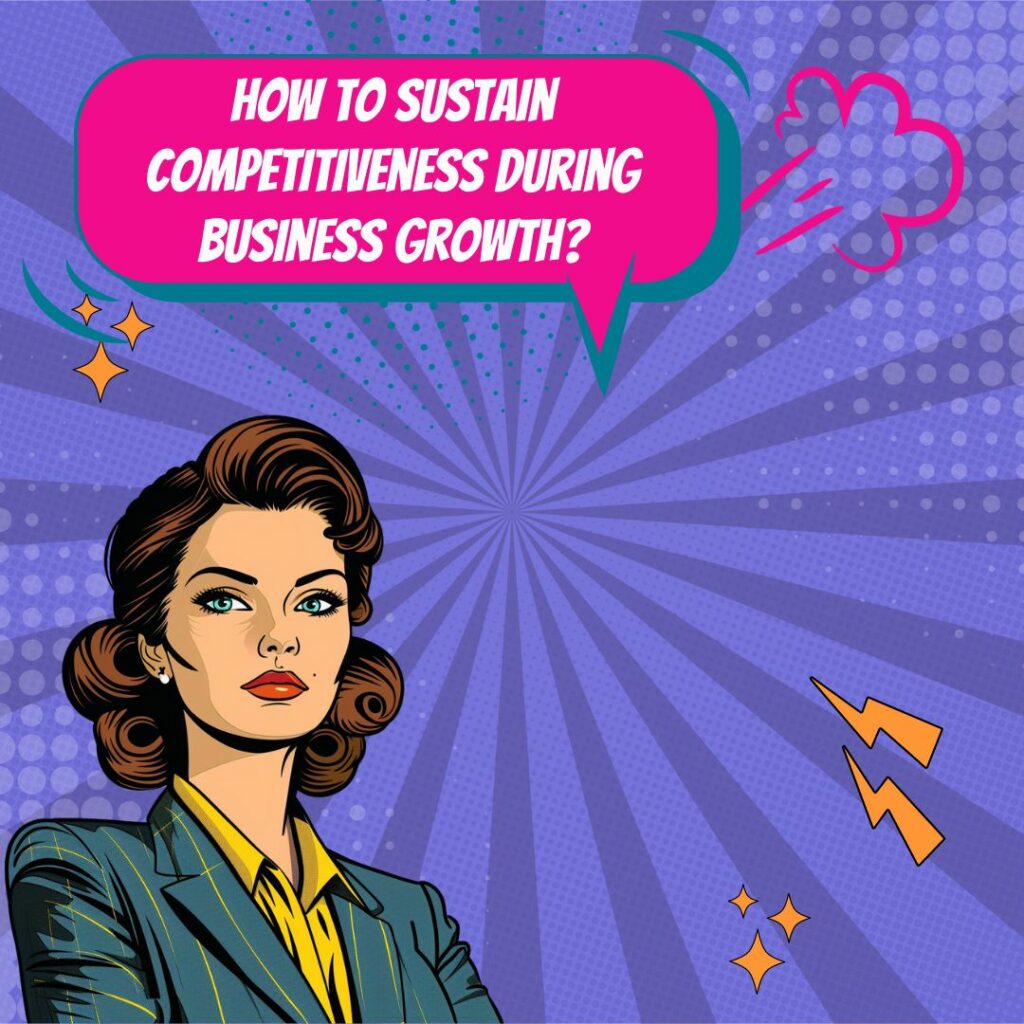Key Takeaways
✅ Focus on Differentiation and Innovation: To set your business apart in a sea of competitors, it's crucial to carve out a unique space. Surveys reveal that 72% of consumers prefer companies that personalize their interactions. By tailoring your product or service, recruiting innovative minds, and prioritizing continuous improvement, you can not only meet but exceed market expectations. Acting on customer feedback and staying abreast of industry trends are proven methods to keep your offerings fresh and relevant.
✅ Prioritize Customer Experience and Relationships: In today’s market, customer experience can be the dividing line between your business and your competitors. Statistics show that companies focusing on customer experience outperform their competitors by nearly 80%. Enhancing customer interaction at every touchpoint, building loyalty programs, and fostering a culture of feedback creates advocates out of customers, solidifying your market position.
✅ Stay Organized, Analyze Competition, and Adapt: A vigilant eye on the competitive landscape can reveal gaps and opportunities for your business. According to a recent study, 90% of top-performing companies invest in competitive intelligence to guide their strategies. Keeping organized records, conducting regular competitor analyses, and being agile in strategy implementation are essential practices for staying one step ahead. Adaptability, fueled by precise and timely insights, empowers businesses to thrive amidst market shifts.
 Introduction
Introduction
Is your business a silent giant waking up in a battleground of giants? Staying competitive is not just a goal; it's the survival kit for any business aiming for longevity and success. Keeping Your Business Competitive as It Grows is more than a mantra—it's a meticulous process of evolution, adaptation, and strategic foresight. As industries evolve at a breakneck pace, understanding how to leverage Competitive Analysis, Customer Relationships, and Innovation becomes your lighthouse in the storm of market fluctuations.
In a landscape where 50% of businesses don't make it past the five-year mark, the importance of staying ahead cannot be underestimated. This article is your compass in navigating the complexities of growth without losing your competitive edge. Through a blend of proven strategies, modern trends, and actionable insights, we promise not only to guide you but also to equip you with the tools needed to maximize your revenue, ROAS, and ROI. Prepare to discover groundbreaking information that will transform your approach to competition and drive sustainable growth.
Top Statistics
| Statistic | Insight |
|---|---|
| 90% of Fortune 500 companies use competitive intelligence | Shows the high value large companies place on competitive intelligence to stay ahead in the market. |
| 73% of enterprises dedicate 20% of their budget to research and data analytics | Highlights the critical role of research and data analytics in understanding market trends and making informed decisions. |
| Data analytics makes decision-making 5x faster for businesses | This demonstrates the impact of data-driven decisions on the speed and efficiency of business operations. |
| Companies analyze only about 12% of their data | Indicates a massive opportunity for businesses to leverage the 88% of untapped data for competitive insights. |
| 81% of marketers expect to compete primarily on customer experience | Emphasizes the growing importance of customer experience as a key differentiator in the marketplace. |
Why Competitive Analysis is Your Business Compass
Imagine sailing a ship through treacherous waters without a compass. Daunting, right? That's where competitive analysis steps in for businesses venturing into the vast seas of their industry. It's not just about collecting data on competitors’ products, sales, and strategies; it’s about understanding your position in the race. By identifying both your strengths and areas for improvement, competitive analysis becomes the guiding star for strategic decision-making. It’s fascinating to note that companies dedicating time to this process are more likely to spot opportunities and make pivots that keep them ahead of the curve.
Knowing Your Competitors Inside and Out
To truly grasp your competitive landscape, you must look beyond the obvious rivals. Identifying direct and indirect competitors offers a panoramic view of the challenges and opportunities lying ahead. Direct competitors are those fighting in the same ring as you, offering similar services or products. In contrast, indirect competitors are the ninjas operating in the shadows, solving your customers' problems in unique ways. Including both in your analysis shines a light on unseen angles and unexplored territories that could be critical for your strategy.
The Power of Market Research
Understanding the battlefield requires more than knowing your opponents. Conducting thorough market research dives deep into market size, growth dynamics, trends, and customer preferences. This rich mosaic of information helps businesses connect the dots between what the market demands and what it's currently getting. Insights into demographic and psychographic profiles of the target audience can unearth golden opportunities for innovation and growth. It’s surprising how many companies overlook these gems, only to realize their value when competitors have already taken the lead.
Crafting a Competitive Framework
Creating a competitive framework is like drawing your own map of the terrain. This involves setting up a matrix to compare various facets such as market share, product quality, pricing strategies, and distribution channels among competitors. Such a framework illuminates your business's relative strengths and weaknesses, guiding you towards strategic initiatives that address critical gaps. Did you know that businesses that regularly refine their competitive framework adapt more swiftly to market changes, often leading the pack in innovation and customer satisfaction?
Visualizing the Competitive Landscape
With heaps of data collected, the challenge is to make sense of it all. Visualizing the competitive landscape with charts, tables, and infographics transforms raw data into a compelling story. This clarity is invaluable, not just for the marketing team but for all stakeholders involved. It democratises the information, allowing every team member to see where the company stands and how it can navigate its way to the top. Visual aids are not just about presentations; they are powerful tools for collective understanding and informed decision-making.
Tracking and Monitoring Results
Lastly, the true measure of a strategy’s effectiveness lies in its results. Tracking and monitoring these results ensures that the strategies deployed are yielding the desired outcomes. Regularly updating the competitive analysis keeps your strategies fresh and relevant. It's surprising how quickly the marketplace can evolve, rendering yesterday’s innovative tactics obsolete. Staying vigilant and adaptable is not optional; it’s critical for those who wish to lead.
In the ever-changing landscape of business, understanding your competitive environment is not just a good practice; it's a necessity. The insights gained from a comprehensive competitive analysis can illuminate the path to growth, innovation, and long-term success. Whether you're a startup finding your footing or an established player aiming to maintain your lead, remember — knowledge is power, but understanding puts you in control.
AI Marketing Engineers Recommendation
Recommendation 1: Prioritize Customer Experience with AI and Data Analytics: In today's fast-paced market, Keeping Your Business Competitive as It Grows isn't just about selling a product or service; it’s increasingly about the experience surrounding it. With 73% of customers citing experience as an important factor in their purchasing decisions, according to a Salesforce study, leveraging AI and data analytics to personalize customer interactions can set your business apart. Use AI to analyze customer behavior and preferences, then tailor your offerings and communication strategies accordingly. This will not only enhance customer satisfaction but also foster loyalty and increase value over time.
Recommendation 2: Embrace Agile Marketing Strategies: The business landscape is continually evolving, driven by changes in consumer behavior, technology advancements, and global market trends. To ensure Keeping Your Business Competitive as It Grows, adopting agile marketing strategies that allow for rapid response to market changes is key. This approach helps businesses stay relevant and responsive. For instance, by closely monitoring online consumer feedback and market trends through social listening tools, your business can quickly adapt marketing strategies to meet customer needs and preferences, staying one step ahead of the competition.
Recommendation 3: Leverage Content Marketing for Long-Term Engagement: In the digital age, content is king. A solid content marketing strategy is crucial for Keeping Your Business Competitive as It Grows. By creating and distributing valuable, relevant, and consistent content, businesses can attract and engage a clearly defined audience. According to HubSpot, content marketing gets three times more leads than paid search advertising. Start by identifying the issues and needs of your target audience. Then, use blogs, videos, podcasts, and social media to provide solutions and insights, establishing your business as a leader in its field. This not only boosts brand visibility but also builds lasting relationships with your audience.
Conclusion
Keeping Your Business Competitive as It Grows is not just about watching what others are doing; it's a commitment to understanding the dynamics of your industry, recognizing who your real competitors are (both direct and indirect), and constantly scanning the horizon for market shifts and customer preferences. The journey starts with a thorough competitive analysis, which arms you with the insights needed to benchmark your performance and strategize effectively. This process, from identifying competitors to conducting in-depth market research, forms the bedrock of strategic decision-making.
Creating a competitive framework and visualizing the competitive landscape are more than just exercises in data collection. They're about painting a picture of where you stand in the market and where the opportunities for growth and improvement lie. The importance of tracking and monitoring your performance cannot be overstated, as it offers a real-time snapshot of your strategies in action, highlighting both wins and areas needing adjustment.
But what makes this all meaningful? The values associated with staying ahead in the game. Not just keeping pace, but setting the pace. The business world is ever-evolving, with new challenges and players emerging all the time. To thrive, staying static is not an option. Your business needs to be as dynamic as the market it operates in. The insights gained from your analyses should inspire innovation, drive your marketing strategies, and influence product development.
In wrapping up, remember that keeping your business competitive as you grow is an ongoing process of learning, adapting, and outmaneuvering. It's about being proactive rather than reactive. So, use the insights and frameworks discussed here not just as a one-off exercise but as integral parts of your growth strategy. Embrace change, encourage innovation, and always keep an eye on the horizon for the next opportunity to stand out. The path to sustained growth and success is paved with the insights gained from looking not just within your business but outward at the ever-changing market landscape.
FAQs
Question 1: What is competitive intelligence?
Answer: Competitive intelligence is the process of gathering and analyzing information about your competitors to gain insights and make informed business decisions.
Question 2: Why is competitor analysis important?
Answer: Competitor analysis helps you understand your market position, identify opportunities, and develop strategies to differentiate your business and stay competitive.
Question 3: What are the key questions to ask when analyzing competition?
Answer: Key questions include: What products and services do your competitors offer? How do they market and deliver their offerings? What are their strengths and weaknesses? How do they retain top talent? What are the gaps in the market that you can fill?
Question 4: How do you identify your competitive advantage?
Answer: Identify your unique value proposition by understanding what problem you solve, how you address customer pain points differently, and what specific benefits set you apart.
Question 5: How do you differentiate yourself from competitors?
Answer: Differentiate by focusing on innovation, performance, sustainable technology, or exceptional customer service. Conduct competitor analysis to identify areas where you can excel.
Question 6: How can technology enhance your competitive advantage?
Answer: Leverage technology to streamline operations, improve customer experience, and provide a competitive edge. Stay informed about industry trends and implement digital solutions to improve efficiency and gain market insights.
Question 7: What is the importance of building strong relationships?
Answer: Strong relationships with customers, suppliers, and partners foster trust, loyalty, and word-of-mouth referrals, giving you a competitive advantage in customer retention and acquisition.
Question 8: How do you innovate and adapt to changing market dynamics?
Answer: Foster a culture of innovation and continuous improvement. Encourage employee creativity, embrace feedback, and stay informed about industry trends to drive innovation and stay ahead.
Question 9: How do you create a competitive strategy plan?
Answer: Develop a plan that reacts to changes and competitor moves. Identify your advantages, understand your competitors' strengths and weaknesses, and focus on differentiating yourself.
Academic References
- Porter, M. E. (1985). Competitive Advantage: Creating and Sustaining Superior Performance. New York: Free Press. This foundational work explores the underlying frameworks that enable businesses to achieve and sustain competitive advantages, emphasizing the importance of strategy in shaping financial performance over time.
- Barney, J. B. (1991). “Firm resources and sustained competitive advantage.” Journal of Management, 17(1), 99-120. In this article, Barney discusses the relationship between a firm's resources and its ability to maintain a competitive advantage, providing a critical foundation for understanding resource-based views in strategic management.
- Teece, D. J., Pisano, G., & Shuen, A. (1997). “Dynamic capabilities and strategic management.” Strategic Management Journal, 18(7), 509-533. This paper introduces the concept of dynamic capabilities and how they enable organizations to adapt to changing markets and environments, forming a crucial part of competitive strategy theory.
- Kim, W. C., & Mauborgne, R. (2004). “Blue Ocean Strategy.” Harvard Business Review, 82(10), 76-84. Kim and Mauborgne challenge the traditional focus on competition by arguing for the creation of uncontested market spaces, or ‘Blue Oceans,’ where competition is irrelevant. This article provides insights into innovative strategies that drive business growth by avoiding direct competition.
- Porter, M. E. (2008). “The Five Competitive Forces That Shape Strategy.” Harvard Business Review, 86(1), 78-93. This article is an extension of Porter's earlier work, providing an in-depth look at the five forces that affect competitive intensity and market attractiveness. The framework aids businesses in understanding their industry context and shaping their strategic approach accordingly.












